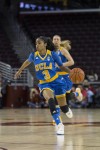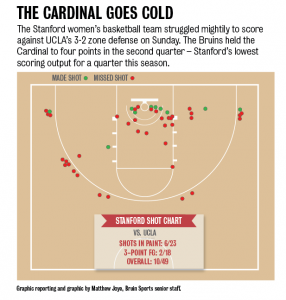When the Stanford women’s basketball team was heading back home, the players were probably thinking about hands.
During Sunday’s 56-36 loss to No.15 UCLA, the Cardinal saw a lot of them. Hands were in the passing lanes, hands were in the faces of the shooters, hands were denying entry passes to the post. The entire game was a blizzard of Bruin hands, constantly forcing the Cardinal (15-5, 5-3 Pac-12) into bad positions.
That smothering defense has been a common theme this season. UCLA (14-5, 6-2) has developed a reputation of making life difficult for their opponents on offense.
“Their pressure was really effective tonight. They forced us into a lot of mistakes. They used their athleticism well,” said Oregon State coach Scott Rueck after his then-No. 11 Beavers lost in Pauley earlier this month. “They need to be commended for that. They do a great job.”
UCLA’s defensive success comes from the athleticism of its backcourt. The guards have the ability to keep their assignment in front of them and make their defensive assignment uncomfortable. The Bruins apply further pressure by trapping in the corners and are quick enough to rotate back if the opposing offense is able to get a clean pass out of the trap. This clean pass, however, usually doesn’t happen, and guards Jordin Canada and Nirra Fields are waiting when a weak pass gets lofted into the air. Canada, a sophomore, has 47 steals this season while senior Fields has 40, putting them at second and third respectively in the conference in steals per game.
“It all comes down to defense,” Fields said. “Teams (in the conference) know everything we’re going to run, teams are scouting you, we’re going to play teams twice, sometimes three times,” Fields said. “It really comes down to the last four minutes and defense and getting stops.”
When the guards are not getting steals, they are forcing difficult shots. They don’t allow easy looks around the perimeter, and teams are shooting only 26.6 percent from 3-point range against them this season, the third lowest mark in the Pac-12. Stanford especially struggled from range, going 2 for 18 from beyond the arc.
“I thought we’ve been doing a much better job this year, chasing people off the 3-point line, anticipating (the 3),” said coach Cori Close after a December win over CSU Bakersfield.
When Canada or Fields come out of the game, freshman guard Kennedy Burke steps up on the defensive end as well. At 6-foot-1, her length bothers ballhandlers trying to make passes. There was a sequence against California on Friday in which Burke deflected three passes in one possession.
“(Making deflections) is really one of my biggest strengths right now,” Burke said.
Despite coming off the bench, her 30 steals this season are tied for 11th in the conference and she has a higher steals per minute rate than both Canada and Fields.
The team still has a lot of room to improve. Its defensive rebounding is inconsistent and it can sometimes look reckless in transition. The consecutive wins against the Northern California teams overshadowed what was an underwhelming trip to the Washington schools the week before.
At the same time, there was a reason people seemed to have forgotten about Washington. The win against Stanford was convincing, and UCLA’s backcourt looked relentless. They looked eager to take down the Cardinal powerhouse. They looked ready for March.
With contributing reports by Logan Patton, Bruin Sports contributor.

